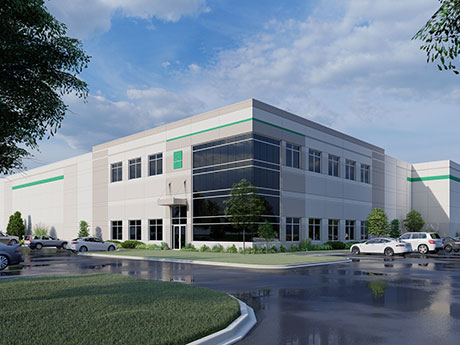By Noel Liston, Core Industrial Realty
The 10 major submarkets that comprise the broader Chicagoland industrial market all performed at or above expectations in 2023. While absorption was not as robust as the pandemic boom that saw back-to-back record years, 2023 was a solid year for absorption and a strong year in rental growth throughout the broader market.
Significant deliveries of speculative developments were offset with solid absorption by manufacturing, assembly and food & beverage-related industries that picked up the slack left from a less enthusiastic e-commerce market.

Broadly speaking, the greater Chicagoland industrial market started 2024 with a vacancy rate of ±7.3 percent. This vacancy rate is up from the low 5 percent range the market averaged for the second half of 2023.
Assuming equilibrium (a market that favors neither tenant nor landlord) for the market is historically a ±6 percent vacancy rate, the current vacancy rate can be deceiving. This is, in large part, due to the jump in vacancy as a result of the delivery of a significant amount of larger, speculative industrial developments in certain submarkets where land zoned for industrial with relatively good access to a major highway or interstate was still available.
Further, some of the major infill submarkets still carry vacancy rates as low as 2.9 to 4 percent. Certain submarkets such as Northwest Indiana and Southeast Wisconsin carry much higher vacancy rates, pushing the overall vacancy rate for the greater Chicagoland industrial market north of equilibrium.
Limited development sites
Considering the lack of pad-ready industrial zoned sites as well as the known planned developments for 2024, there will be a significant drop in deliveries of new available speculative industrial product. Factoring in steady absorption as evidenced by robust activity to start the year, and it is likely that the overall vacancy rate will get to and drop below equilibrium favoring landlords again in mid-to-late 2024.
The critical impact that labor constraints are having on manufacturing, distribution, food & beverage, and service-related industries severely restricts industrial development in unestablished secondary and tertiary markets. With a strong occupancy rate in place within these established submarkets, a balance of supply and demand, and extremely limited virgin land opportunities, the existing portfolios are positioned to continue to perform well moving forward.
The lack of functional available industrial product within the established Chicagoland submarkets has prompted companies in need of space to consider purchasing speculative industrial buildings as opposed to seeking land for a design-build transaction. Core Industrial Realty recently represented Component Plastics in its purchase of a 144,000-square-foot speculative development by Seefried Industrial Properties in Elgin, Illinois, located in the I-90 submarket.
Purchasing the building in shell condition enabled Component Plastics to customize the interior to reflect its required manufacturing improvements within the facility.
Panattoni Development recently completed and delivered a speculative building of 365,000 square feet located in Aurora, Illinois, which is within the I-88 submarket. Panattoni has recently completed a lease for over half of this building with a local manufacturer of fire suppression systems, and activity remains brisk on the balance of the building.
Factoring in zoning considerations within the greater Chicagoland area and all the respective submarkets are very well-positioned to withstand most any risk associated with current lending concerns that may be impacting other asset classes and/or some industrial assets in secondary or tertiary markets.
We anticipate core infill industrial markets within the Chicagoland area to perform well, holding the rental gains achieved during the pandemic. We expect rent growth to continue at a more moderate pace, but still healthy in the 3.5 to 4 percent range.
The Chicagoland industrial market benefits from three critical factors for industrial operations: geography, labor and infrastructure.
Having all four major U.S. railroads converge in multiple intermodals in the Chicagoland area as well as truck access to a good majority of the U.S. population greatly benefits the Chicagoland industrial market.
Productive and affordable labor is key to any industrial operation. Whether it be simple warehousing, e-commerce-related activities, or operations that contain presses, machines and assembly lines, the Chicagoland labor market remains a critical part of why companies locate in this region. Automation might lighten the load a bit for the need to source labor, but there will always be a demand for physical bodies to run and oversee the activities ongoing in an industrial building.
Labor constraints persist throughout the United States and weigh heavily on geographic preference for industrial locations. Modest softening in the labor market in the second half of 2023 was primarily contained to the white-collar industries and not service, manufacturing or assembly industries.
Reshoring is happening. Not just to the United States but also to Canadian and Mexican industrial markets that have a periphery benefit to U.S. centralized markets such as the Chicagoland industrial area. A renewed focus on last-mile fulfillment centers will provide additional absorption for well-designed speculative industrial projects within key core submarkets such as the greater Chicagoland submarkets.
Capital costs have appeared to peak and are starting to moderate and likely decline sometime in the third and fourth quarters of this year. Capitalization rates for new industrial developments within the Chicagoland submarkets should edge lower due to more favorable financing options as a result of reduced borrowing costs and ability for investors to achieve positive leveraged yields.
An ongoing rally in stocks has already pushed down government bond yields. The U.S. 10-year Treasury yielded 5 percent on Oct. 19 and now stands at ±4 percent as of Feb. 1.
Lastly, capital far exceeds the supply of preferred new industrial leased assets that will be available for sale throughout 2024 and 2025. Limited portfolio sales will drive up pricing for single or multiple industrial asset sales throughout the Chicagoland industrial market. While 2024 may not be a record-breaking year, it will prove rewarding and will remain resilient throughout 2024 based on all the factors above.
Noel Liston is a managing broker with Core Industrial Realty. This article originally appeared in the March 2024 issue of Heartland Real Estate Business magazine.


